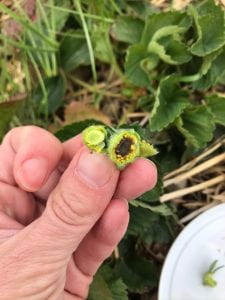Please join us on Thursday, May 14th at 12:30pm to discuss how to detect frost and freeze damage to buds, and what, if anything, you might do to help remaining fruit set.
Click link below to join the Berry Office Hours

https://cornell.zoom.us/j/95514586018
Or dial by phone: 1-646-518-9805
Meeting ID: 955 1458 6018
Assessing Cold Damage on Berries
This past week has seen multiple nights at or below freezing, depending on location. This unseasonably cold weather has been stressful for berry growers. Those who chose to do frost protection with overhead sprinklers have had many sleepless nights and very wet fields to contend with. Some who used row covers were fighting high winds to keep those covers on, and are sometimes still seeing damage, where the buds have advanced to bloom and were too sensitive for the conditions. Probably the vast majority of small growers were not set up to do anything for frost protection, and have been trusting that the cold spring has held the plants back enough that the buds would tolerate some degree of frost.
The truth of that is yet to be seen as we move into bloom, but I expect that almost all fields will have some level of damage from the cold. Most strawberries and blueberries that I have seen in Western New York were still at a stage that should theoretically survive a frost, even down to 25°-26°F, but these were especially difficult conditions, with rain, snow and wind, which may have aggravated the simple temperature effects. Now that the cold nights are past, we can get out and start estimating the amount of damage. Cutting buds is a familiar activity for tree fruit growers

, but it works for berries too. You need a razor blade or a sharp knife and preferably something hard to cut against. Select the most advanced bud(s) that you can find, then slice across the fattest part of the bud. If the tissue inside is green and firm, then the bud is probably fine. If the center of the bud is black or grey and soggy, then it has been killed and will not produce a berry. If you are finding black buds, sample more, of different stages and from different parts of the field. There may be more damage in a particularly windy area, or a low spot where the cold settled. I’m also seeing more damage in strawberry fields where the plants are weak, and the limited canopy left the emerging buds more exposed. In strawberries, often only the ‘king’ flower (the first to emerge) will be killed, and the secondary ones will be fine. That primary flower produces the largest berry, so your fruit size might be down a bit, but there should still be plenty of medium sized berries to pick.
So far, I haven’t seen any clearly damaged blueberry buds, but I suspect they will be showing up. Blueberries are at their most vulnerable to cold as the corollas drop (after bloom), and most WNY fields are still at tight cluster to pink.
Sometimes frost won’t kill the bud, but damage it enough that pollination and fruit set are reduced. This might be the year to bring in bees (or extra hives) to make sure that the flowers you do have get pollinated. With the forecast for next week predicting a quick warm-up, the bloom period may be quite short, making pollinators even more critical. To improve pollination wait to introduce bees until bloom is at least 5% but before 25%. Blueberry flowers are less attractive to honeybees and unless there are LOTS flowers open, the bees will find alternate nectar sources. Hive stocking density should be 0.5 – 2.5 hives per acre depending on variety. Bluecrop is suggested at 1.5 hive/acre; Elliot at 2 hives/acre; Earliblue at 2.5 hives/acre.
As we see warmer temperatures and rain predicted over the next week, disease concerns return.
In Blueberries:
- Plan for bloom fungicide applications to prevent fruit molds. Botrytis blossom and twig blight can be controlled at pink. Many of the same fungicides labelled for mummyberry will control botrytis. Anthracnose fruit rot is best controlled by a fungicide application right at bloom. There are many different fungicides that can help manage these fruit rots – the key is timing. Pink and Bloom should be the focal points of the sprays.
- Cool, moist weather is perfect for Mummyberry. Research shows that mummyberry infection temperatures hover between 45O and 60O Abound and Indar are excellent choices for both Botrytis and Mummyberry at the pink stage. If you miss this spray window, then focus on bloom. The bloom spray is designed to prevent flower infections. It’s important when primary shoot blight infections were not controlled. Substituting captan in the mixture may be preferred if Phomopsis canker is a problem. Mixtures with captan may be repeated at 7 to 10-day intervals throughout bloom if rain occurs. Discontinue use of Ziram DF or Ziram Granuflo as they are labeled only for the shoot blight phase, not flower infection. Highest levels of control are often achieved by using either Pristine WG or Indar 2F.
In Strawberries:
- At least 2 well timed fungicide sprays to protect against Botrytis makes a huge difference to berry quality. For organic growers there is some evidence that Regalia can help control Botrytis and Fruit Anthracnose – but mostly in grapes or in combination with conventional materials. Still – it’s something. There is also a new biological product called Botrystop specifically marketed for organic management of Botrytis – we’d love to hear from anyone who has tried it. Botrytis sprays should start at 10% bloom.
